
Contents










Story · Written by Park Jina Photographed by Studio Kenn
Mystical Wonder of the Island
Jeju-do Island, a UNESCO World Natural Heritage, is filled with environmental assets recognized not
only in Korea but also worldwide. A mystical tale of the island’s birth told for generations tells of a giant
named Seolmundae Halmang. She carried sand with her skirt and built in the middle of the sea an
island called Jeju-do. The pile of sand she made became Hallasan Mountain, while the lumps of earth
that fell through her torn skirt became parasitic cones.
Gotjawal is like a secret garden that Seolmundae Halmang seems to have hidden deep inside the island. Jeju-do Island is the only place in the world where plants from the northern limits of tropical regions and those in the southern limits of polar regions coexist. This uniquely formed forest and topography are called Gotjawal. In Jeju dialect, got means “forest” while jawal refers to a location where trees and vines are tangled together in loosely built rock piles. Gotjawal is broadly established both east and west of Hallasan Mountain, and thus serves as a lung that enables the island to breathe.
A cozy vibe gently wraps the body once visitors step into Gotjawal. Though occasional winds fiercely pass over the tree branches, the forest is generally tranquil and snug, filled with only the sound of nature, from the crisp noise of grass leaves to that of fleeting birds. When standing still with eyes closes, you will feel as if the forest is breathing. In most parts of Gotjawal, water is not collected on the ground but rather permeates into the earth even during heavy rainfall. The forest, however, also features several wetlands with permanent pooling of water. The Gotjawal in the village of Seonheul-ri, called Donbaekdongsan, is one of them.
Dongbaekdongsan features rocks covered in green moss, trees twisted in their own random directions and red camellias in full bloom. The camellias here exude more elegance than glamor. Gotjawal, which is a registered Ramsar site, has several ponds. The look of the forest reflected in the water is more mystical than the others. The forgotten childlike innocence is resurrected at Gotjawal. As going deeper into the forest, you will feel as if a cookie house or cabin with small windows will appear. Will fairies come out at night to have a festival? Leaving behind an overflow of imagination caused by nature, it’s time to move to the next destination.
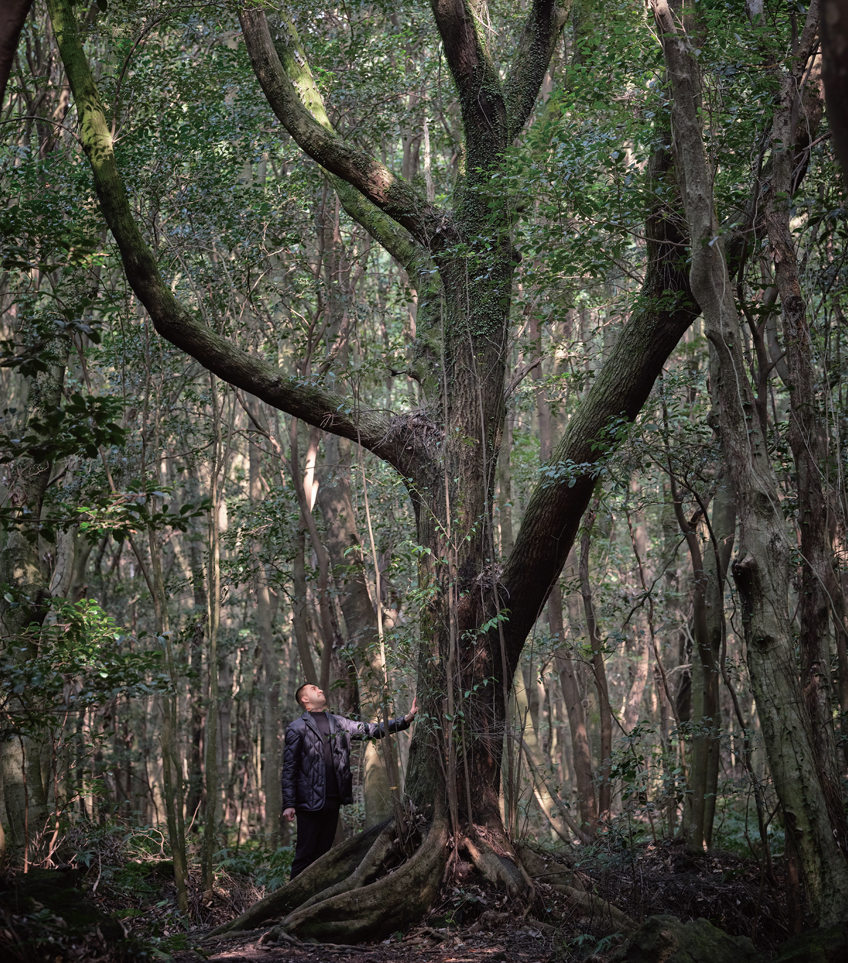
Living Landscape
Anywhere along the coastal road of Jeju is greeted by picturesque scenery. In seasons with nice weather, many people ride electric bicycles to enjoy the island’s refreshing breeze. Enormous wind power generators are seen in the distance. The environment of Jeju, which is known as windy, is perfect for manufacturing eco-friendly energy. Rather than unconditionally keeping a distance from nature for protection, Jeju residents have learned (and are still learning) how to coexist with nature. To create a carbonless island, authorities have put a lot of effort into distributing and normalizing the operation of electric vehicles. As a result, the number of visitors who travel to the island in electric cars continues to rise.
Driving on a coastal road where the sky and the ocean seem to be one, head toward Seongsan Ilchulbong (Sunrise Peak). Ninety-nine rocky peaks that surround the sunken crater at the top look like the high walls of an impenetrable fortress, from which the name “Seongsan” originated. While charging an electric car at a nearby station, hike up the cone. Looking back after walking up a neatly established path for a while, the landscape of Jeju will seem to have expanded a few inches at a time below your feet. Descend on stairs heading toward the beach to reach Haenyeo House, where the island’s female divers haenyeo perform at sea. Despite no stage, the performance is nonetheless meaningful just with the appearance of the divers, who have lived their entire lives around the island’s waters.
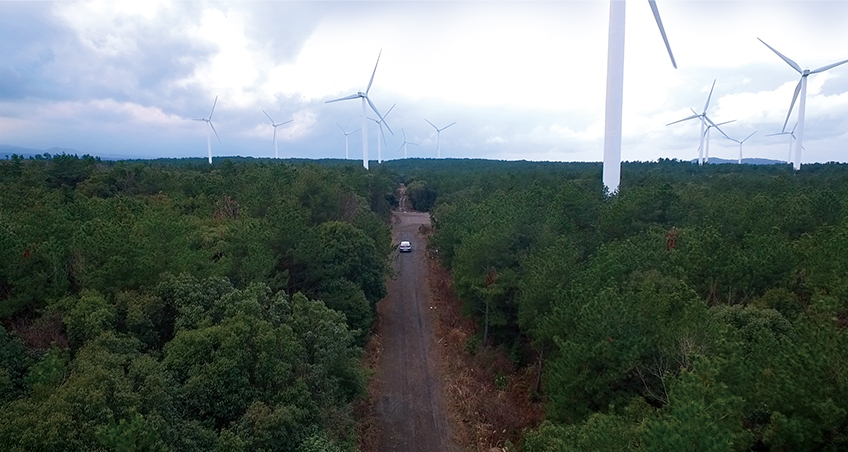
An extraordinary experience is taking a temporary forest road while riding an electric car and looking at spinning windmills.
The performance begins with a song by the divers. A folk song that Jeju’s ancestors used to sing while going out to sea on a traditional fishing boat, “Teu,” excites the audience. As the song ends, the divers enter the water, go into the sea and skillfully collect seafood with no equipment. The life and culture of haenyeo has been listed on UNESCO’s Intangible Cultural Heritage of Humanity. These divers who make a living in the sea with their bodies show the strong vitality the island holds.
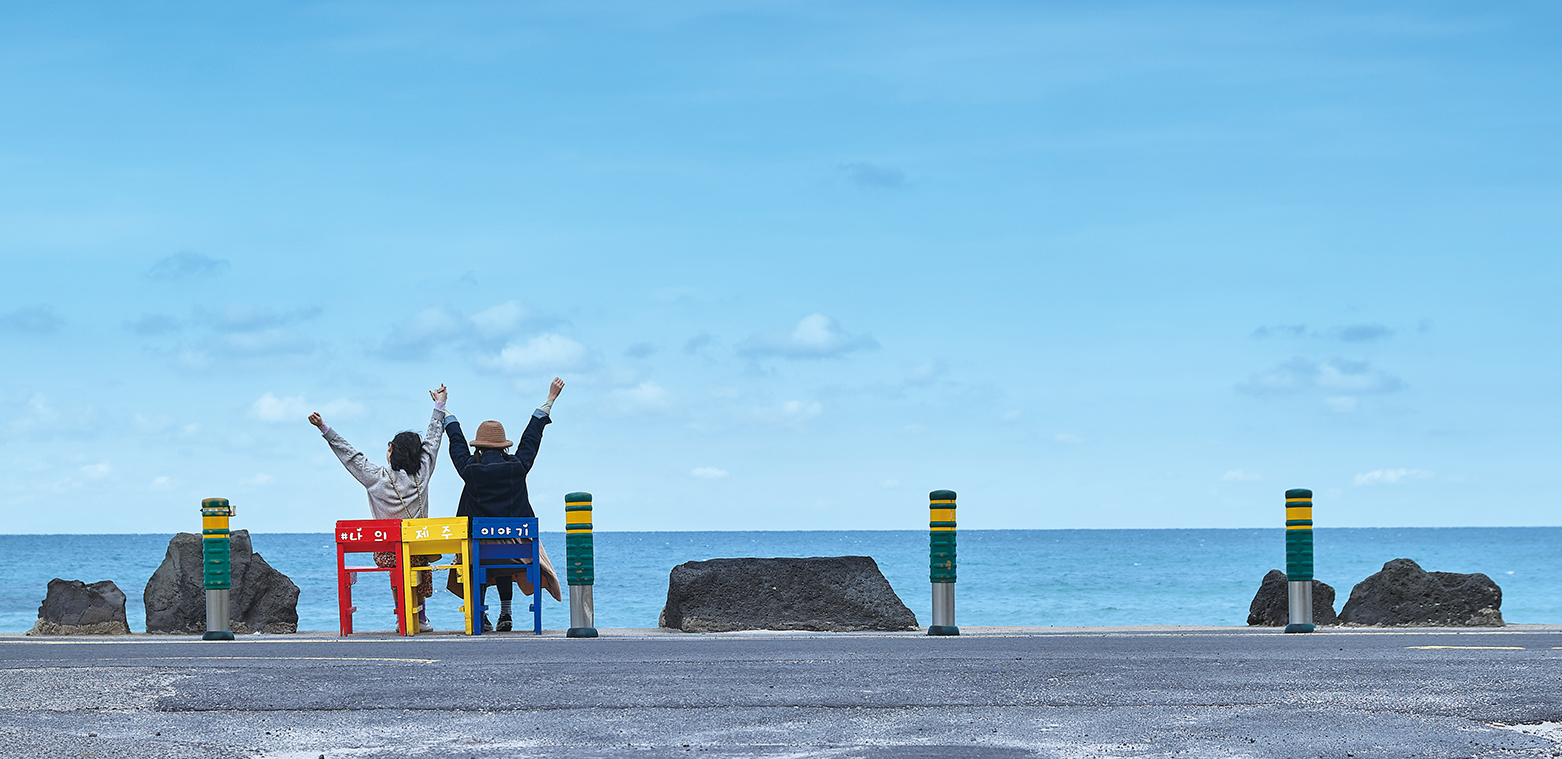
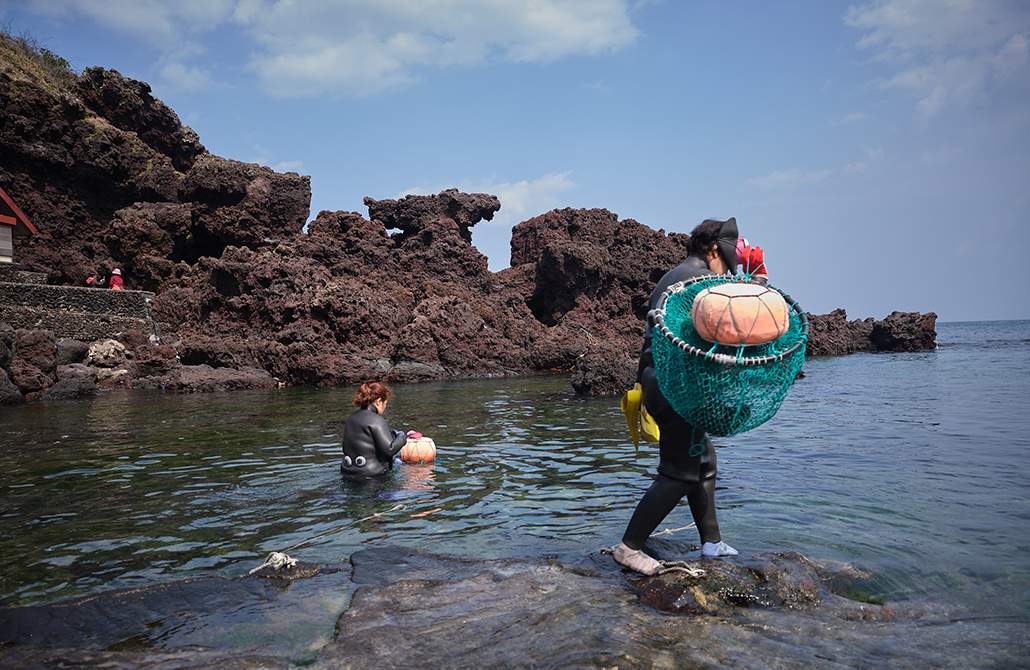
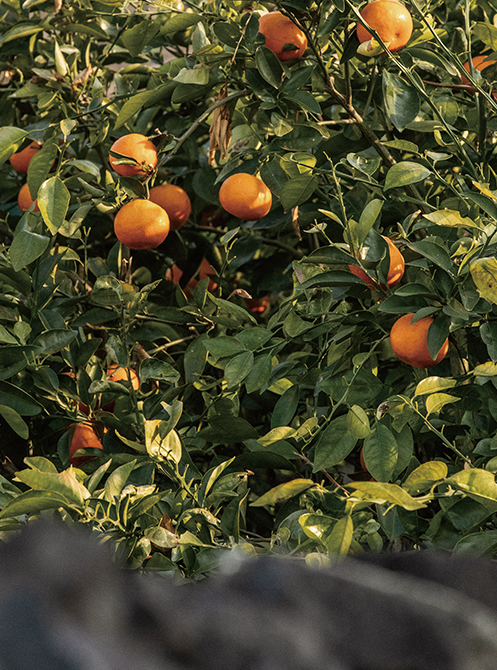
Travelers enjoying the view of Woljeong beach
With weather permitting from Seongsan Ilchulbong (Sunrise Peak), one can see twice a day a group of haenyeo (female divers) going under water to catch shellfish. / Tangerines hang over a stone wall while exposed to rain and wind.
Where Love Flows
A stream of water flowing down from Hallasan Mountain becomes Hyodoncheon Stream in the island’s southern region. The small dry stream is still a beautiful place created by lava and decorated by beautifully shaped rocks and cliffs. At Soesokkak Estuary located at the stream’s mouth, strange-looking rocks stand tall on the sides like screens and a forest grows thick over them, which completes a mystical view. The name “Soesokkak” also comes from Jeju dialect, with soeso meaning a “pond where a bull lies” and kkak meaning the “final end.” A blue pond appears between the rocks and trees and laughter is heard from people enjoying the scenery of the estuary and stream on a boat.
In old times, ceremonies praying for rain were said to be held at Soesokkak Estuary when the island faced droughts. Due to the sacred image of the site, people were banned from throwing around stones or playing in the water. The area is also known to be where bay salt was made by blocking the entrance of the valley, and is now part of the Jeju Olle Trail. Instead of enjoying the stream and the estuary via water activities, visitors should tread the rocks with their feet and walk along the valley. From sunlight beaming through the thickly wooded forest to the softness felt in the feet and other gorgeous spectacles that slowly appear in various places, the magnificent scenery will strike onlookers with awe.
Soesokkak Estuary is also the scene of a legendary love story between the only child of a rich family and the son of a servant at the family’s house. Depressed over the wide difference in their social classes, the man threw himself into waters at Namnaeso, located in the estuary’s upper region. Upon learning of her lover’s death, the distraught woman visited Prayer Rock at the estuary for 100 days, praying for his body to be salvaged. The ensuing heavy rains that came resulted in the man’s body being washed to shore. She cried with his body in her arms before climbing Prayer Rock and throwing herself into the pond. To honor this star-crossed couple, the villagers built the shrine Halmangdang at the estuary. Legend goes that a prayer made here will make one’s hope for love come true.
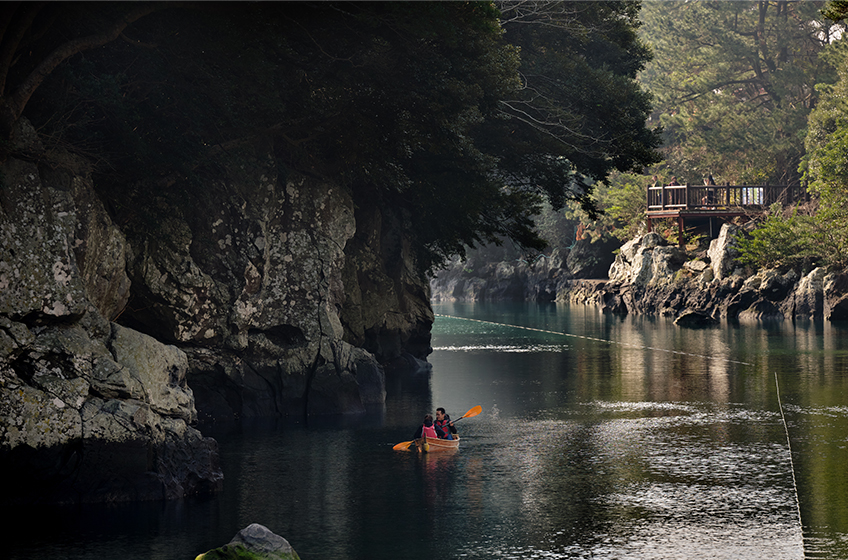
A canoeing tourists look around Soesokkak Estuary.
Spirit of Coexistence
Jeju-do Island’s beauty mostly lies in its more than 370 volcanic cones, which included Jeju in UNESCO’s World Natural Heritage list. People say that when someone on the island dies, he or she is buried in a volcanic cone. Gods who protected villages are also enshrined in cones. So the proper Jeju experience requires a hike up a volcanic cone, thus the last stop of this trip is Darangswi Oreum. From a tidy appearance that resembles a hanbok (traditional Korean attire) skirt spread out to a neatly organized path toward the top, there is no better location on the island to enjoy a night view while reflecting on Jeju nature experienced to this point.
The island takes on an impressive appearance when the sun begins to set. The sunset featuring colorful shades slowly spreads between volcanic cones and over the horizon, enlightening and inspiring those who gaze at it. On the way up Darangswi Oreum, you will encounter the impressive beauty of Jeju, the balance formed by the peak, the sunken crater that looks like the moon and the lovers who complete such a gorgeous scene on the island. Hiking up the cone just in time to see the sunset, couples hold hands and walk, relaxing or sitting side by side to share the wind, sea and sunset. JMG Le Clézio, the winner of the 2008 Nobel Prize for Literature, once said the most impressive thing about Jeju is its beauty. As more people abroad discover the beauty of nature on Jeju, efforts for the protection and preservation of nature on the island are more pressing than ever. Projecting the nature of the island’s original form into daily life as is instead of forcibly bringing it to the present and going beyond modest acts for protecting nature to effectively coexist with it.
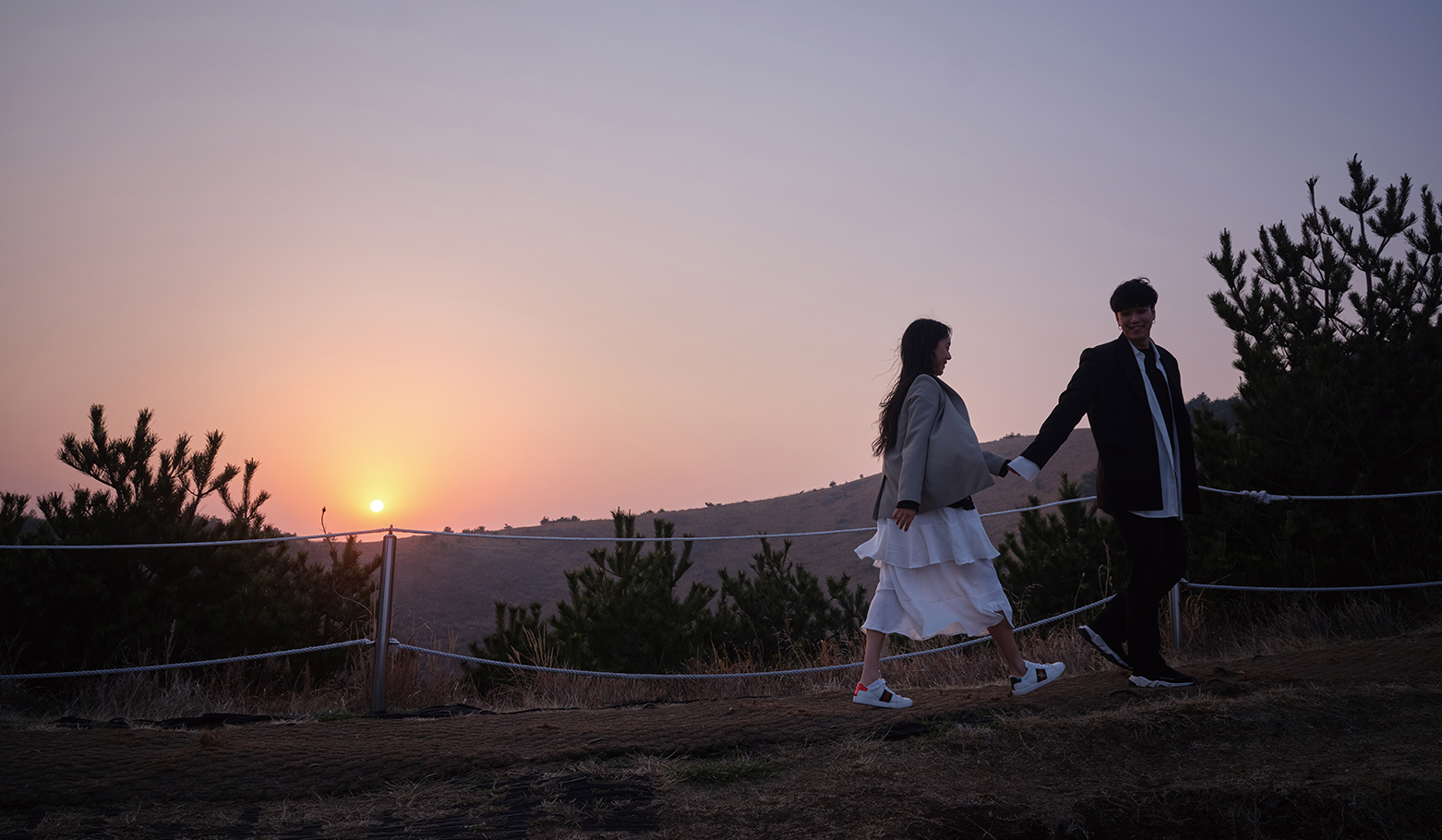
A couple visits oreum (volcanic cone) with the sunset in the background.
Other Articles






Hanbok Designer Extraordinaire



Bridging Korean and Vietnamese Culture






